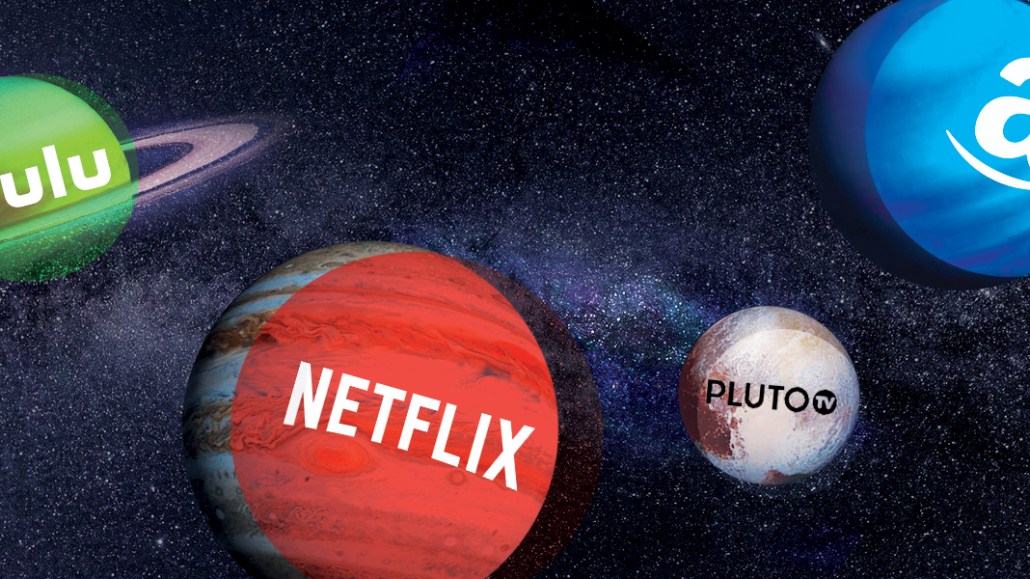Save 50% on a 3-month Digiday+ membership. Ends Dec 5.
Subscription-based streamers outstrip ad-supported services’ share of watch time

Ad-supported streaming services have some catching up to do. Subscription-based streaming services, which are largely ad-free, continue to dominate the amount of time people spend streaming video. But there is an opportunity for ad-supported streamers to edge into subscription-based services’ share of audiences’ attentions.
Of the time that people spent streaming video in 2020, 62% was spent on subscription-based services versus 32% on ad-supported services, according to a survey of 1,000 U.S. adults conducted by auditing and consulting firm PwC.
The reason for the gap may not be a simple matter of people preferring to watch movies and shows without commercial interruptions. That’s a likely contributing factor, but another consideration is that “there are a lot more [subscription-based] platforms than [ad-supported] platforms,” said Todd Supplee, partner at PwC.
With the exception of Hulu, the preeminent streaming services have been subscription-based and sans ads. Netflix and Amazon Prime Video have historically dominated the market, and more recently Disney’s Disney+ and WarnerMedia’s HBO Max have risen the ranks without relying on advertisers for revenue.
However, the past year — and this year in particular — has seen an increasing influx of major ad-supported streamers. Last July, NBCUniversal’s Peacock rolled out nationally in the U.S. Then in January, Discovery debuted Discovery+. And in June alone, both HBO Max and ViacomCBS’s Paramount+ will have added ad-supported tiers to their respective services.
The ad-supported streaming landscape “is significantly different than it was 18 months ago. It’s been like a hockey stick,” said one agency executive.
The introduction of more ad-supported streamers has coincided with an increase in the overall number of streaming services that people use. In 2020, the typical person used, on average, nearly eight streaming services — including free services — compared to six in 2019, according to PwC.
Ad position: web_incontent_pos1
While people are using more streaming services, the market among major ad-supported streamers is still settling. For example, the audience overlap among the major ad-supported streamers is relatively minimal, said a second agency executive. Moreover, each of the aforementioned major ad-supported services, as well as Hulu, provide ad-free tiers, and their primary ad-supported tiers still require people to pay a monthly fee. That can make it hard to gauge how their ad-supported viewership may change month to month.
Nonetheless, the growing number of streaming services offering high-quality shows and movies and charging for access may lead more people to opt for the cheaper ad-supported tiers to access a wide array of programming without breaking the bank.
In PwC’s survey, 63% of respondents said they would be willing to sit through more ads if it meant lower subscription prices. “There are people that have budget constraints,” Supplee said.
What’s unclear, though, is how many more ads people would be willing to sit through. Ad-supported streamers have used their low ad loads as a selling point, at least to advertisers. Compared to traditional TV, which typically features 16 minutes’ worth of ads per hour of programming, NBCUniversal’s Peacock has capped its ad load at five minutes of ads per hour, where Discovery+ and HBO Max have maxed out at four minutes. The lower ad loads are intended to make the services more attractive to audiences accustomed to seeing zero ads on Netflix or to being able to zip through ads through their traditional TV DVRs. And that idea has made them more attractive to advertisers.
“I do like the limited ad loads and decreasing interruptions. It’s making a more consumer-friendly ad experience,” said a third agency executive.
More in Future of TV

Future of TV Briefing: The streaming ad upfront trends, programmatic priorities revealed in Q3 2025 earnings reports
This week’s Future of TV Briefing looks at what TV and streaming companies’ latest quarterly earnings report indicate about the state of the streaming ad market.

Future of TV Briefing: The creator economy needs a new currency for brand deals
This week’s Future of TV Briefing looks at why paying creators based on reach misses the mark and what IAB is doing to clear up the creator-brand currency situation.

Future of TV Briefing: WTF is IAB Tech Lab’s device attestation tactic to combat CTV ad fraud?
This week’s Future of TV Briefing breaks down the CTV ad industry’s new tool for fighting device spoofing.
Ad position: web_bfu




